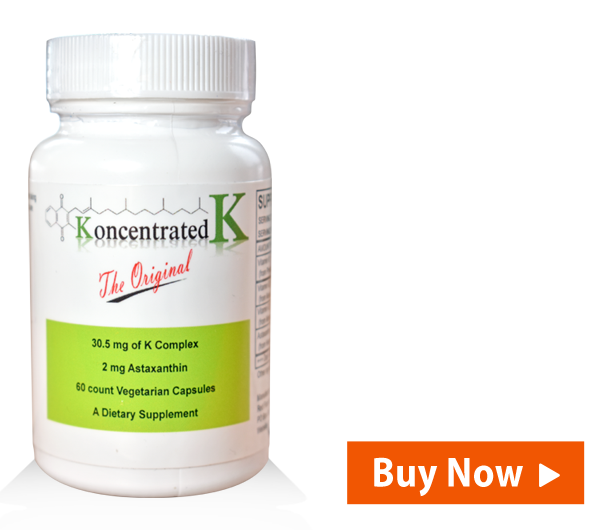Koncentrated K
Vitamin K – An Introduction
Vitamin K and its "Brothers and Sisters" are one of the least recognized but most indispensable vitamins in the human body, and it appears that many people are deficient. This website intends to provide an understanding of the vital role that Vitamin K and the Vitamin K derivatives, apparently play in the wellbeing of the body. The following is a brief review of the short history of Vitamin K research, a synopsis of the emerging research to date, our personal experience and knowledge of what dosages would be apparently restorative, and an understanding of the product Koncentrated K, which contains concentrated doses of several different types of Vitamin K, along with astaxanthin. This is now available to buy online.
Vitamin K1 is typically known for its role in blood clotting, but as you will read, the research indicates it is vital to the healthy functioning of many bodily tissues. Vitamin K2 is a subgroup of the K family, and research has identified two types of vitamin K2, Mk7 and Mk4, to be highly beneficial to different organs and systems of the body.
Koncentrated K is in the form of a capsule that is formulated with vitamin K1, Mk7, Mk4, and Astaxanthin which is considered to the be the best anti-oxidant available. Koncentrated K includes these key vitamins at a biologically effective dosage, meaning it contains enough of the K vitamins to maintain your regular bodily requirements as well as the extra amounts your body may need to reverse the disease process that can begin as a result of a vitamin K deficiency. Research has shown that many people do not have enough vitamin K in their bodies to maintain basic health requirements, much less to gain the health and curative benefits it offers.
Koncentrated K is formulated to address those deficiencies.
If you are wondering why your physician has not suggested that you take vitamin K or vitamins in general, it is due to the fact that the current state of medical education and practice is heavily focused on poly-pharmacy which is the prescribing of multiple synthetic drugs as a primary mode of treatment. Few, if any, medical programs focus on the holistic education that would aid in disease prevention and disease reversal via nutrients like vitamins, and how supplementing with a vitamin can be more effective than drugs that have many damaging and toxic side effects. If you doubt this, ask your doctor how many classes he had on vitamins and holistic treatment while in medical school, the answer should be near zero.
I found this out from personal experience, when I was diagnosed with Coronary Artery Disease in 2002, and was given four years to live. You can read more on this at My Story, and you’ll understand how motivated I was to survive this, and to share with others what I learned myself. I hope it is helpful for you, as it is the truth!
On the right side of the page, you will find an image of the vitamin bottle. If you hover your mouse over the image, it will enlarge, allowing you to read the label itself in detail. If you would like more information, you can read the details on the Koncentrated K formulation on the Product page. If you are interested in learning more, the Cardiac page offers an introduction to the scientific research that has been compiled on the cardiac benefits of the vitamin K family. On the Bone page, we offer a summary of the research on the bone health benefits of the vitamin K family. The Kidney page describes how the disturbances in mineral metabolism resulting from kidney dysfunction create a multisystem disorder, where vitamin K helps stabilize functioning and reduces complications. The Cancer page describes the research on micronutrient deficiency as a risk factor for cancer, and how intake of vitamin K is associated with a lowered risk for some types of cancer, as well as serving as a treatment agent. We have had profound personal benefit from vitamin K, which we have shared on the My Story page. On the Cardiac Manifesto, we offer our understanding of how heart disease forms, and how it can be reversed, an understanding that differs from the current orthodoxy of the medical establishment whom are heavily influenced by the pharmaceutical industry. The Cardiac Manifesto is based on logic and extensive personal experimentation to find the right formula for cardiac health.
We are excited to offer Koncentrated K and if you have any questions, please be in touch through our Contact Us page. For those who wish to learn more, what follows on this page is background information on vitamin K and a brief review of its history, findings from the ongoing scientific research being done on vitamin K, and recent understandings of its functions in human health.
Some History
Recent research seems to suggest that we’ve only begun to understand what a potent force Vitamin K can be to human health. Vitamin K has been known since the early 20th century, primarily for its blood coagulation properties (clotting). It was first observed by a Danish scientist, Henrik Dam, at the Biochemical Institute of the University of Copenhagen in Denmark in the late 1920s, and he called it ‘Vitamin K’ after the first letter of the Scandinavian word “koagulation” (Dam, 1935). Vitamin K occurs naturally in two forms: Vitamin K1 (phylloquinone), is found in plants, and Vitamin K2 (menaquinones), is the term for a group of compounds which are synthesized by bacteria in the intestinal track of humans and various animals.
(Click here for a Chart on the Vitamin K Content in Foods.)
In 1940 Dam received half of the Nobel Prize for his discovery of vitamin K and its blood coagulation factor, and Edward Albert Doisy, of St. Louis University, received the other half of the Nobel Prize for his discovery of the chemical nature of vitamin K. There has been renewed interest in Vitamin K since the 1970s, and the identification of Gla, gamma-carboxyglutamate, which is a product of vitamin K action, has made it possible to search for vitamin K-dependent proteins (Berkner, 2005). For instance, it appears that Vitamin K helps to regulate calcium in both bone and the arteries, through Gla. The identification of Gla has been an important advancement. At this time, at least 17 Gla-proteins have been discovered, and the research indicates that these Gla-proteins have key functions in many metabolic processes and are synthesized in a wide variety of tissues. The discovery of these proteins and their importance to health are only beginning to be explored, and I believe the research already supports the significance of vitamin K for human health (Ferland, 2012).
Chemistry
Research has shown first and foremost that the forms of vitamin K are not toxic at any reasonable/rational dosage. Research has also shown that both Vitamin K1 and the different forms of K2 play a crucial role in virtually every bodily function, each with their own role(s). They both are co-factors for an enzyme that catalyzes the carboxylation of glutamic acid residues on vitamin K-dependent proteins. Carboxylation is the chemical modification of proteins triggered by the presence of Vitamin K. Carboxylation is a “good thing”- you want it happening in your body!
Thus far, over 17 proteins have been identified that are vitamin-K dependent (VKD), meaning they need vitamin K to be activated and functional. Some of the key vitamin K-dependent proteins discovered thus far include coagulation proteins such as Factor II (Prothrombin), VII, IX and X, anticoagulation proteins such as C, S and Z. Also highly researched are osteocalcin which is important for bone health and is part of the glucose cycle, and matrix-Gla protein, which is has been established as a major calcification inhibitor and is regarded as a protector of vascular and tissue integrity (Wei, Trenson et al, 2019). There is also growing evidence implicating activated MGP in a wide range of age-related chronic diseases, including maintaining microvascular integrity and preserving the structure and function of vital organs, including the retina (Borras et al, 2015; Asokan et al 2018; Wei et al, 2018), kidney (Wei, et al, 2016, Wei et al, 2018; Puzantian et al, 2018), and heart (Schurgers et al, 2004; Wei Trenson et al, 2018).
Emerging for more study are Gas6 (growth arrest specific-6), Gla-rich protein (GRP), and periostin (Ziao et al, 2021).
Gas6 is widely expressed in the brain, heart, lung, kidney and other tissues (Wen et al, 2018) and assists the developing and aging nervous system and cell regulation and the vascular system (Ferland, 1998: Tsaioun, 1999; Maree, 2007). Gas 6 acts as a protective factor in human atherosclerosis (Clauser et al, 2012; Holden et al, 2019). And Gas6 protects from acute kidney injury and is involved in chronic kidney disease (van der Meer et al, 2014).
GRP is one of the newst VKD proteins and it is found both in skeletal and connective tissues, including bone, cartilage, skin and the vasculature. GRP has an unusually high capacity to bind calcium through Gla residues, it accumulates in bone, cartilage and ectopic calcification, such as blood vessels and skin (Husain et al, 2017). GRP contributes to bone homeostasis and delays the progress of osteoarthritis (Cavaco et al, 2016; Viegas et al, 2008; Viegas et al, 2009; Cancela et al, 2012; Bordoloi et al, 2018), and GRP is considered a novel effective antagonist against cancer (Lee et al, 2020).
Periostin participates in the progression of cardiac fibrosis, idiopathic pulmonary fibrosis and airway remodeling of asthma. It is particularly expressed in connective tissues that are submitted to constant mechanical stresses, such as periodontal ligament, heart valves and skin (Coutu et al, 2008; Nakazawa T et al, 2004). Periostin is highly active in bone remodeling after a fracture (Kashima et al, 2009; Neagu et al, 2016; Kudo 2019).
The discovery of these vitamin K-dependent proteins is very significant, as it highlights how widely disbursed they are in many tissues of the body. As an example, recent research highlighted the placement of vitamin K1 and MK4 in the body. They found that K1 was the predominant form in the blood, liver and heart, whereas MK4 was found in relative higher concentrations in kidney, pancreas, brain, and adipose tissue (Ferland et al, 2020).
Prior to the discovery of these proteins, there was little or no recognition of the role and need of vitamin K, and with the discoveries of these proteins, there has been a steady expansion of research to understand better their relationship to health.
To Review:
Vitamin K is not a single compound, but a group name for a family of fat-soluble compounds that all share a chemical ring system with a variable side chain (Shearer, 1995). To be a fat-soluble compound means they are carried on the LDL and HDL particles. These side chains are called isoprenoids (a fancy name for a "tail"), and are made from two or more hydrocarbons, each containing five carbon atoms. In phylloquinone, vitamin K1, the side chain has four isoprenoid residues or 5-carbon units, the last three of which are saturated (don't worry, you won't be tested on this). Menaquionones, vitamin K2, form a sub-family in which the length of the side chain may change from 1 to 13 isoprene residues. There are different types of vitamin K2, and the differences are reflected in the number next to the K. There have been up to 15 different Menaquinones discovered, and they are differentiated by the name Menaquinone followed by a number, such as Mk7 (easier than spelling it out). The number refers to the number of isoprene residues comprising the side chain of the molecule (Shearer, 1997). Thus Mk7 possesses seven isoprene units in the side chains. In recent years, the menaquinones Mk4 and Mk7 have increasingly been the focus of research.
Here is what they "look like", along with Astaxanthin. Notice the "tails".
|
|
|
| K1 |
MK7 |
 |
|
| Astaxanthin |
MK4 |
Some Functions of Vitamin K
Research suggests that vitamin K deficiency is associated with osteoporosis, heart disease, and cancer (see the published research pages). Research also indicates that the need for vitamin K increases with age and that older individuals require higher amounts of vitamin K to keep adequate levels of carboxylated vitamin K available in their bodies (Tsugawa, et al. 2006). This appears to coincide with the increasing need for Vitamin D as we age, as one also loses the ability to produce vitamin K as they advance in age. For example, a 70 year old only produces 10% of the vitamin D that a 21 year old produces. And research indicates that vitamin D was reported to stimulate vitamin K2 carboxylation for osteocalcin production in cultured human osteoblasts (Miyake, et al, 2001).
Vitamin K also may be a stronger antioxidant than vitamin E and may be key to anti-aging (Li et al, 2003; Gheduzzi, et al., 2007). Inflammation lies at the bottom of chronic metabolic diseases (Shea et al, 2007) and vitamin K is a potent antioxidant (Vervoort et al 1997). In vitro studies show that vitamin K decreases the production of proinflammatory cytokines (Juanola-Falgarona, 2013; Ohsaki et al, 2006; Reddi et al, 1995).
Sufficient quantities of Vitamin K in the body are necessary for the activation of these proteins in the body to take place, which then allows the proteins to bind calcium, and to move it around, and to function as an essential regulator of calcium and magnesium metabolism within the body, and specifically in bones, the heart, the arteries, the kidneys, teeth, etc. Vitamin K helps ensure that calcium is bound to the surface of bones, that calcium is inhibited from depositing in the arteries, that kidney stones do not form, and that blood coagulates, among other things (Shearer, 1997; Booth, 1997; Suttie, 2006; DiNicolantonio et al, 2015). The vitamin K family appears to be really "busy".
Without Vitamin K, the proteins are unable to move the calcium around appropriately, and carboxylation of these proteins is incomplete. The results may be what is known as the “calcium paradox” whereby too little calcium results in weak bones and teeth, while excess calcium accumulates in the arteries making them stiff and inelastic. This is not good!
Sources of Vitamin K
Vitamin K1 is in most diets, naturally, as it is formed in plants and may be obtained in small amounts from olive oil, soybean oil, cottonseed oil, and canola oil, though hydrogenation of vegetable oils may decrease the absorption and biological effect of dietary vitamin K (Booth, 2001) due to only a partial hydrogenation of the K molecule. K1 is also found in leafy green vegetables, such as chard, spinach, watercress and lettuce, broccoli, and kale, because it is directly involved in photosynthesis. Green vegetable-rich western diets contain large amounts of vitamin K1.
The problem is that vitamin K1 obtained from fresh vegetables is very poorly absorbed. Only about 10-20% reaches circulation and as K1 has a very short serum half life, only a small amount is able to reach peripheral parts of the body. Moreover, vitamin K is initially is absorbed by the liver to secure coagulation – with little left over for other tissues. It is believed the body operates on the triage theory (McCann & Ames, 2009), when during poor dietary supply, vitamins are preferentially utilized for functions that are important for immediate survival, and in this case, vitamin K is utilized for clotting factors, and the other bodily needs of the body become deficient – unless one takes supplements (Vermeer, 2012). Our Koncentrated K product is specifically formulated to provide enough of the vitamin Ks, so that the initial clotting needs are met, while ensuring that additional amounts are available for the other body tissues – we call it a biologically effective dose.
In Koncentrated K, we provide vitamin K at a level beyond what one could eat on a daily basis.
Vitamin K2 is of bacterial origin produced either by gut metabolism of K1 or obtained from a few fermentation products such as Hard Cheeses, Sauerkraut or Natto, a Japanese product made from fermented soy bean which is rich in MK7 (Kaneki, et al, 2001). Research done in Japan, in those regions where there are low levels of heart disease and osteoporosis, shows that the best source of K2 is the traditional Japanese dish, natto, a Japanese breakfast food made of fermented soy beans. Additional K2 (specifically MK4) may be found in animal fat and animal organs such as the pancreas and the liver.
The different forms of K are transported through the intestinal wall and then transported to the liver. Vitamin K1 is preferentially retained in the liver to assist carboxylation of clotting factors (Schurgers & Vermeer, 2001). In contrast, vitamin K2, particularly long chain derivatives, are redistributed to the circulation and are available for extra-hepatic tissues such as bone and vasculature. There are long chain menaquinones, such as MK7, MK8, and MK9, and shorter chain menaquinones, such as MK4. The long chain menaquinones are different from vitamin K1, enabling K2 to be bound to other fat particles in circulation such as LDL (low density lipoproteins) and set free in the bloodstream (Schurgers and Vermeer, 2002). While vitamin K1 in circulation is mostly associated with triacylglycerol-rich lipoproteins (TLR).
Research indicates that vitamin K1 showed larger inter individual variation in the concentrations found in blood (Booth, Tucker et al, 1997) and wasn't absorbed as well as MK4 and other longer chain menaquinone food sources (Schurgers & Vermeer, 2000). This difference could also justify the higher half-life time, bioavailability, and higher bioactivity of MK-7 when compared with vitamin K1. A study comparing vitamin K1 and MK-7 shows that MK-7 had a half-life time of 68 h compared with only 1–2 h for K1 (Schurgers et al, 2007). MK7 thus survives longer in the circulation, manifested in its very long serum half-life and is absorbed almost completely (Schurgers & Vermeer, 2000; Shearer et al, 2012). This makes it available longer to be absorbed by extra-hepatic tissues (Schurgers et al, 2007).
K2 can also be produced within the human body by beneficial bacteria colonizing the intestines. However the intestinal production/absorption seems to be minimal, contributing little to the body’s vitamin K requirements especially for bones and arteries. Therefore, the daily requirement for vitamin K2 has to be supplemented from dietary sources, such as curd, cheeses and other fermented dairy products shown to contain vitamin K2.
However, you would need to have an extremely high consumption of these foods in order to get a sufficient amount of vitamin K2. As natto and/or kimchi remains unpopular in the western world, supplementation with additional vitamin K2 is the optimal alternative to getting an adequate amount of Vitamin K into your system. Koncentrated K includes a therapeutic dose of K2 in two different forms, MK4 and Mk7, as both of these have been associated with different body tissues and benefits.
Vitamin K and Health
There is a growing body of research that points to the critical significance of Vitamin K. Vitamin K acts on many systems of the body through its dependent proteins, or regulation of gene transcription, or antioxidant impact, thus it plays a much larger role than previously assumed (Niemiec et al, 2020). Prolonged vitamin K deficiency is a risk factor for osteoporosis, atherosclerosis, Alzheimer’s, and cancer (Willems et al 2014; DiNicolantonio et al, 2015; Wen et al 2018; Harshman et al, 2016). Supplementing with vitamin K before irreversible organ damage sets in might help prevent a wide range of disabling diseases. (Wei et al, 2019). Nutrition represents one of the easiest choices one can make for health (Ahmadieh et al, 2011; Sadler et al, 2024).
Present recommendations for dietary intake are based on the daily dose required to prevent bleeding and only to prevent bleeding. The present recommendations do not account for the different needs by other tissues in the body and the potential health benefits of vitamin K beyond coagulation (Beulens et al 2013; Teuwissen et al 2014). Research has shown that only with supplementation, by taking a capsule of vitamin K, do adults begin to completely carboxylate or make use of the vitamin K in their bodies and benefit from the protection that it provides (Cranenberg, et al. 2008; Theuwissen, et al. 2014; Jadhav et al, 2022).
Prolonged vitamin insufficiency may not be life-threatening with immediate effect, but forms a risk factor for the development of age-related diseases (Hey & Brasen, 2015; Jakubowski et al, 2019; Halder et al, 2019). Some research indicates that vitamin K insufficiency is as high as 30% of the population (Riphagen et al, 2017). Accumulating scientific data suggests that new, higher recommendations for vitamin K intake should be formulated and that people do not take enough Vitamin K (Vermeer, 2012; El Asmar et al, 2014; Liu et al, 2015: Schwalfenberg, 2017; Arkbulut et al, 2020; Kuwabara et al, 2023). Some research has highlighted deficiencies in vitamin K levels in folks who have become critically ill (Dahlberg et al, 2019). And the PREVEND study found that vitamin K insufficiency associated with all-cause and cardiovascular mortality (Riphagen et al, 2017; Jakubowski et al, 2019).
Remember: Your body has many ways of “making things happen” but at a terrible long-term price to your health and length of life. By making certain that you have more than enough vitamin K to benefit from the protection, you are ensuring that your body will not make compromises that could lead to a disease process beginning. Koncentrated K provides doses of three different types of vitamin K at levels high enough to have an effect on any disease process that may have begun, and enough to forestall any diseases that may begin as a result of vitamin K deficiency.
1930s
Dam H. The anti-haemorrhagic vitamin of the chick: occurrence and chemical nature. Nature. 1935;135:652-3.
1940s
Dam H. The Discovery of Vitamin K. Its Biological Functions and Therapeuthical Application. Nobel Lecture, December 12. 1946.
1970s
Stenflo J, Ganrot PO. Vitamin K and biosynthesis of prothrombin. J Biol Chem. 1972;247:8160-166.
Nelsestuen GL, Zytkovicz TH, Howard JB. The mode of action of vitamin K identification of gamma-carboxyglutamic acid as a component of prothrombin. J Biol Chem. 1974;249:6347-50.
Shah DV, Suttie JW. The vitamin K dependent, in vitro production of prothrombin. Biochem Bioiphys Res Commun. 1974;60:1397-1402.
Shearer, MJ, McBurney A, Barkhan P. Studies on the absorption and metabolism of phylloquinone (vitamin K1) in man. Vitam Horm. 1974;32:513-42.
Stenflo J, Fernlund P, Egan W, Roepstorff P. Vitamin K dependent modifications of glutamic acid residues in prothrombin. Proc Natl Acad Sci USA. 1974;71:2730-2733.
Almquist HJ. The early history of vitamin K. Am J. Clin Nutr. 1975;28:656-59.
1980s
Olson RE. The function and metabolism of vitamin K. Annu Rev Nutr. 1984;4:281.
Suttie JW. Vitamin K-dependent carboxylase. Annu Rev Biochem. 1985;54:459-77.
1990s
Vermeer C. Gamma-carboxyglutamate-containing proteins and the vitamin K-dependent carboxylase. Biochem J. 1990;266:625–36.
Ferland G, Sadowski JA, O’Brien ME. Dietary induced subclinical vitamin K deficiency in normal human subjects. J Clin Invest. 1993 Apr;91(4):1761-8.
The study showed that Gla responds to changes in dietary intake, an age-dependent process, but several days are needed to observe any alterations.
Conly J, Stein K. Reduction of vitamin K2 concentrations in human liver associated with the use of broad spectrum antimicrobials. Clin Invest Med. 1994;17:531-39.
Reddi K, Henderson B, Meghji S, et al. Interleukin 6 production by lipopolysaccharide-stimulated human fibroblasts is potently inhibited by naphthoquinone (vitamin K) compounds. Cytokine. 1995;7(3):287-90.
Shearer, MJ. Vitamin K. Lancet. 1995: 345(8944): 229-34.
Research indicating that vitamin K is not a single compound but a group name for a family of related structures that all share a methylated naphthoquinone ring system substituted with a aliphatic side chain. In K1, the side chain is composed of four isoprenoid residues, the last three of which are saturated. K2 form a sub family in which the length of the side chain may range from 1 to 13 isoprene residues.
Suttie JW. The importance of menaquinones in human nutrition. Ann Rev of Nutri. 1995;15:399-417.
Booth SSL, Pennington JA, Sadowski JA. Food sources and dietary intakes of vitamin K1 (phylloquinone) in the American diet: data from the FDA total diet study. Journal of the American Dietetic Association. 1996;96:149-4.
Gijsbers BL, Jie KS, Vermeer C. Effect of food composition on vitamin K absorption in human volunteers. Br. J Nutr. 1996 Aug;76(2):223-9.
People absorb K2, phylloquinone, from plants about one and a half times slower than the vitamin K from a supplement.
Sakamoto N, Kimura M, Hiraike H, Itokawa Y. Changes of phylloquione and menaquinone-4 concentrations in rat liver after oral, intravenous and intraperitoneal administration. Int J Vitam Nutr Res. 1996;66:322-8.
Booth SL, Tucker KL, McKeown NM, Davidson KW, Dallal GE, Sadowski JA. Relationships between dietary intakes and fasting plasma concentrations of fat-soluble vitamins in humans. J Nutr. 1997;127:587-92.
Shearer, MJ 1997. The roles of vitamins D and K in bone health and osteoporosis prevention. Proc Nutr Soc. 1997;56:915-37.
Sokoll LJ, et al. Changes in serum osteocalcin, plasma phylloquinone, and urinary gamma-carboxyglutamic acid in response to altered intakes of dietary phylloquinone in human subjects. American Journal of Clinical Nutrition. 1997;65:779-84.
Vervoort LMT, Ronden JE, Thijssen HHW. The potent antioxidant activity of the vitamin K cycle in microsomal lipid peroxidation. Biochem Pharmacol. 1997;54(8):871-6.
This study tested the potential antioxidant activity of the vitamin K cycle in lipid peroxidation reactions (thiobarbituric acid reactive substances, TBARS) in rat liver microsomes. The results show that the vitamin K cycle could act as a potent antioxidant, that the active species in all probability is vitamin K-hydroquinone, and that the primary reaction product is the semiquinone. The results also show that the reaction product is processed in the vitamin K cycle to regenerate vitamin K-hydroquinone.
Booth SL, Suttie JW. Dietary intake and adequacy of vitamin K. J Nutr. 1998;128:785-88.
Davidson RT, Foley AL, Engelke JA, Suttie JW. Conversion of dietary phylloquinone to tissue menaquinone-4 in rats is not dependent on gut bacteria. J Nutr. 1998;128:220-23.
Ferland G. The vitamin K-dependent proteins: an update. Nutr. Review 1998;56(8):223-30.
Lamon-Fava S, Sadowski JA, Davidson KW, O’Brien ME, McNamara JR, Schaefer EJ. Plasma lipoproteins as carriers of phylloquinone (vitamin K1) in humans. American Journal of Clinical Nutrition. 1998;67:1226-31.
Ronden JE, Drittij-Reijnders MJ, Vermeer C, Thijssen HHW. Intestinal flora is not an intermediate in the phylloquinone-menaquinone-4 conversion in the rat. Biochim Biophys Acta. 1998;1379:69-75.
Booth SL, O’Brien-Morse ME, Dallal GE, Davidson KW, Gundberg CM. Response of vitamin K status to different intakes and sources of phylloquinone-rich foods: Comparison of younger and older adults. Am J Clin Nutr. 1999;70:368-77.
Cham BE, Smith JL, Colquhoun DM. Interdependence of serum concentrations of vitamin K1, vitamin E, lipids, apoliprotein A1, and apolipoprotein B: Importance in assessing vitamin status. Clin Chim Act 1999;287:45-57.
Furie B, Bouchard BA, Furie BC. Vitamin K-dependent biosynthesis of gamma-carboxyglutamic acid. Blood. 1999;93:1798-808.
Garber AK, Binkley NC, Krueger DC, Suttie JW. Comparison of phylloquinone bioavailability from food sources or a supplement in human subjects. The Journal of Nutrition. 1999;129;1201-03.
Tsaioun KI. Vitamin K-dependent proteins in the developing and aging nervous system. Nutr. Rev. 1999; 57(8):231-40.
2000s
Berkner KL. The vitamin K-dependent carboxylase. J Nurt. 2000;130:1877-80.
Nelsestuen GL, Shah AM, Harey SB. VitaminK-dependent proteins. Vigam Horm. 2000;58:355-89.
Schurgers LJ, Vermeer C. Determination of phylloquinone and menaquinones in food. Effect of food matrix on circulating vitamin K concentrations. Haemostasis 2000 Nov-Dec; 30(6):298-307.
Booth SL, Lichtenstein AH, O’Brien-Morse M, et al. Effects of a hydrogenated form of vitamin K on bone formation and resorption. Am J Clin Nutr. 2001;74(6):783-90.
Kaneki M, Hodges, SJ, Hosoi T, Fukiwara S, Lyons A, Crean SJ, et al. Japanese fermented soybean food as the major determinant of the large geographic difference in circulating levels of vitamin K2: possible implications for hip-fracture risk. Nutrition. 2001;17(4):315-21.
Increasing evidence indicates a significant role for vitamin K in bone metabolism and osteoporosis. In this study, we found a large geographic difference in serum vitamin K2 (menaquinone-7; MK-7) levels in postmenopausal women. Serum MK-7 concentrations were 5.26 +/- 6.13 ng/mL (mean +/- SD) in Japanese women in Tokyo, 1.22 +/- 1.85 in Japanese women in Hiroshima, and 0.37 +/- 0.20 in British women. We analyzed the relation between the regional difference in natto intake and fracture incidence. Natto is high in K2. These findings indicate that the large geographic difference in MK-7 levels may be ascribed, at least in part, to natto intake and suggest the possibility that higher MK-7 level resulting from natto consumption may contribute to the relatively lower fracture risk in Japanese women.
Miyake N, Hoshi K, Sano Y, Kikuchi K, Tadano K and Koshihara Y: 1,25-Dihydroxyvitamin D3 promotes vitamin K2 metabolism in human osteoblasts. Osteoporos Int. 12:680–687. 2001.
Presnell SR, Stafford DW. The vitamin K-dependent carboxylase. Thromb Haemost. 2002;87:937-46.
Schurgers LJ, Vermeer C. Differential lipoprotein transport pathways of K-vitamins in healthy subjects. Biochim Biophys Acta. 2002 Feb 15:1570(1):27-32.
Following intestinal absorption of K1 and K2, the transport of these lipophilic compounds to their target tissues take place via lipoproteins in the bloodstream. During the first four hours after intake all K-vitamins were found to be associated with triacylglycerol-rich lipoprotein (TGLRP). This suggests that initially most of the K-vitamins are transported to the liver. K1 is retained by the liver to be used for clotting synthesis, and K2 are incorporated into LDL and set free in the bloodstream, likely to be taken up by the cells via the LDL receptors and dissolving in the membrane structures of the cells. However, both menaquinones were found in TGRLP and low-density lipoproteins, and MK4 was even present in high density lipoprotein. It explains why menaquinones may have a relatively large impact on extra hepatic vit K status than generally assumed, and that MK9 may form a more constant source of vitamin K.
Booth SL, Martini L, Peterson JW, Saltzman E, Dallal GE, Wood RJ. Dietary phylloquinone depletion and repletionin older women. J Nutr. 2003;133:2565-9.
Erkkila AT, Lichtenstein AH, Dolnikowski GG, Grusak MA, Jalbert SM, Aquino KA, Peterson JW, Booth SL. Plasma transport of vitamin K in men using deuterium-labeled collard greens. Metabolism. 2004;53:215-21.
Huang M, Rigby AC, Morelli X, Grant MA, Huang G, Furie B, et al. Structural basis of membrane binding by Gla domains of vitamin K-dependent proteins. Nat Struct Biol. 2003;10:751-6.
Li J, Lin JC, Wang H, et al. novel role of vitamin K in preventing oxidative injury to developing oligodendrocytes and neurons. j Neurosc. 2003;23(13):5816-26.
Murshed M, Schinke T, McKee MD, Karsanty C. Extracellular matrix mineralization is regulated locally: different roles of two gla-containing proteins. J Cell Biol. 2004;165:623-30.
Nakazawa T, Najajima A, Seki N, Okawa A, Kato M, Moriya H, et al. Gene expression of periostin in the early stage of fracture healing detected by cDNA microarray analysis. J Orthop Res. 2004;22:520-525.
Schurgers LJ, Aebert H, Vermeer C, Bültmann B, Janzen J. Oral anticoagulant treatment: friend or foe in cardiovascular disease? Blood. 2004;104:3231–3232.
In animal models, vitamin K antagonists (oral anticoagulants [OACs]) were shown to induce arterial calcification. To investigate whether long-term OAC treatment may induce calcification in humans also, we have measured the grade of aortic valve calcification in patients with and without preoperative OAC treatment. OAC-treated subjects were matched with nontreated ones for age, sex, and disease. Calcifications in patients receiving preoperative OAC treatment were significantly (2-fold) larger than in nontreated patients. These observations suggest that OACs, which are widely used for antithrombotic therapy, may induce cardiovascular calcifications as an adverse side effect.
Berkner KL. The vitamin K-dependent carboxylase. Annu Rev Nutr. 2005;25:127-49.
The identification of Gla as the result of vitamin K action has made it possible to search for vitamin K-dependent proteins on the basis of their amino acid structure: each protein in which gamma-carboxyglutamate, generally referred to as GLA, is found contains the fingerprint of vitamin K action during its biosynthesis. This has allowed a wide variety of proteins to be found that have key functions in other metabolic processes and are synthesized in a wide variety of tissues and which depend on adequate amounts of vitamin K to function effectively.
Ohsaki Y, Shirakawa H, Hiwatashi K, et al. Vitamin K suppresses lipopolysaccharide-induced inflammation in the rat. Biosci Biotechnol Biochem. 2006;70(4):926-32.
This study used the DNA microarray technique to identify the effect of K status on gene expression in the rat liver. The expression of genes involved in the acute inflammation response was enhanced in rats fed with a K-deficient diet relative to the control and K1-supplemented diet groups. Moreover, dietary supplementation with K1 suppressed the inflammation induced by lipopolysaccharide administration. These results indicate that orally administrated K1 suppressed inflammation in the rat.
Suttie, JW. Vitamin K. In: Shils ME, Shilke M, Ross Ac, Caballero B, Cousins RJ, Editors. Modern nutrition in health and disease. 10th ed. Baltimore: Lippincott Williams & Wilkins; 2006. p. 412-25.
Tsugawa N, Shiraki M, Suhara Y, et al. Vitamin K status of healthy Japanese women: Age-related vitamin K requirement for gamma-carboxylation of osteocalcin. Am J Clin Nutr. 2006 Feb;83(2):380-6.
The research shows that vitamin K needs increase with age and that older individuals (over age 70) require higher amounts of vitamin K to keep appropriate levels of carboxylated (activated) proteins available in the body.
Cranenburg EC, Schurgers LJ, Vermeer C. Vitamin K: The coagulation vitamin that became omnipotent. Thromb Haemost. 2007;98:120-25.
Gheduzzi D, Boraldi F, Annovi G, DeVincenzi CP, Schurgers, LJ, Vermeer C, et al. Matrix Gla protein is involved in elastic fiber calcification in the dermis of pseudoxanthoma elasticum patients. Lab Invest. 2007 Oct;87(10):998-1008.
MGP (matrix gamma-carboxyglutamic acid protein) is known to inhibit soft connective tissue calcification. The data suggested that MGP is present within elastic fibers and is associated with calcification of dermal elastic fibers in patients with PXE, a genetic disorder that results in the mineralization of elastic fibers. Cells from PXE patients produced 30% less Gla-MGP than patients without PXE.
Maree AO, Jneid H, Palacios IF, Rosenfield K, MacRae CA, Fitzgerald DJ. Growth arrest specific gene (GAS) 6 modulates platelet thrombus formation and vascular wall homeostasis and represents an attractive drug target. Curr Pharm Des. 2007; 13(26):2656-661.
Schurgers LJ, Teunissen KJF, Hamulya K, Knapen MHJ, Vik H, Vermeer C. Vitamin K-containing dietary supplements: Comparison of synthetic vitamin K1 and natto-derived menaquinone-7. Blood. 2007a;109:3279-283.
Shea MK, Booth SL, Massaro Jm, et al. Vitamin K and vitamin D status: Associations with inflammatory markers in the framingham offspring study. Am J Epidemiol. 2007;167(3):313-20.
This study looked at vitamin K1 and vitamin D and inflammation in participants of the Framingham Offspring Study. They found that high vitamin K status was associated with lower concentrations of inflammatory markers, suggesting a protective role for vitamin K in inflammation.
Shearer MJ, Newman P. Metabolism and cell biology of vitamin K. Thromb Haemost. 2008 Oct:100(4):530-47.
Structural differences in the different types of vitamin K govern many facts of metabolism of K vitamins including the way they are transported, taken up by target tissues and subsequently excreted. Phylloquinone is transported mainly by triglyceride-rich lipoproteins (TRL) and long-chain MKs mainly by low-density lipoproteins (LDL). TRL-born phylloquinone uptake by osteoblasts is an apoE-mediated process with the LRP1 receptor playing a predominant role. MK4 has a highly specific tissue distribution suggestive of local synthesis. Many studies have shown clinical benefits of MK4 at pharmacological doses for osteoporosis and cancer although the mechanisms are poorly understood. Vitamin K also suppresses inflammation, prevents brain oxidative damage and has a role in sphingolipid synthesis. Anticoagulant drugs block vitamin K recycling and the availability of reduced vitaminK. In humans, MK7 has a greater efficacy than phylloquinone in carboxylating both liver and bone Gla proteins.
Coutu DL, Wu JH, Monette A, Rivard GE, Blostein MD, Glaipeau J. Periostin, a member of a novel family of vitamin K-dependent proteins, is expressed by mesenchymal stromal cells. J Biol Chem. 2008;283:17991-8001.
Cranenburg EC, Vermeer C Koos R, Boumans ML, Hackeng TM, Bouwman FG, Kwaijtaal M, Brandenburg VM, Ketteler M, Schurgers LJ. The Circulating Inactive Form of Matrix Gla Protein (ucMGP) as a Biomarker for Cardiovascular Calcification. J Vasc Res. 2008;45(5):427-36.
Matrix gamma-carboxyglutamate (Gla) protein (MGP) is a vitamin K-dependent protein and a strong inhibitor of vascular calcification. Vitamin K deficiency leads to inactive uncarboxylated MGP (ucMGP), which accumulates at sites of arterial calcification. We hypothesized that as a result of ucMGP deposition around arterial calcification, the circulating fraction of ucMGP is decreased. All four patient populations had significantly lower ucMGP levels. In angioplasty patients and in those with aortic stenosis, some overlap was observed with the control population. However, in the hemodialysis and calciphylaxis populations, virtually all subjects had ucMGP levels below the normal adult range. Serum ucMGP may be used as a biomarker to identify those at risk for developing vascular calcification. This assay may become an important tool in the diagnosis of cardiovascular calcification.
Oldenburg J, Marinova M, Muller-Reible C, Watzka M. The vitamin K cycle. Vitam Horm. 2008;78:35-62.
Viegas CS, Cavaco S, Neves PL, Ferreira A, Joao A, Williamson MK et al. Gla-rich protein is a novel vitamin K-dependent protein presen tin serum that accumulates at sites of pathological calcifications. Am J Pathol. 2009;175:2288-2298.
Booth SL. Roles for vitamin K. Beyond coagulation. Annu Rev Nutr. 2009;29:89-110.
Kashima TG, Nishiyama T, Shimazu K, Shimazaki M, Kii I, et al. Periostin, a novel marker of intramembranous ossification, is expressed in fibrous dysplasia and in c-Fos-overexpressing bone lesions. Hum Pathol. 2009;40:226-37.
Krueger T, Westenfield R, Schurgers L, Brandenburg V. Coagulation meets calcification: the vitamin K system. Int J Artif Organs. 2009;32:67-74.
Krueger T, Westenfeld, Ketteler M, Schurgers LJ, Floege J. Vitamin K deficiency in CKD patients: a modifiable risk factor for vascular calcification? Vitamin K deficiency in CKD patients. Kidney International. 2009 (July);76:18-22.
A review that summarized currently available evidence implicating vitamin K in the pathogenesis of vascular calcification (VC), in particular arterial medial calcification. In doing so, they provide a rationale for an interventional clinical study testing whether vitamin K supplementation can retard VC or even affect cardiovascular mortality in chronic kidney disease patients. Additionally, they give an overview of the current literature indicating potential adverse effects of long-term vitamin K antagonists in this population.
McCann JC, Ames, BN. Vitamin K, an example of triage theory: is micronutrient inadequacy linked to diseases of aging? Am J Clin Nutr. 2009;90:889-907.
The triage theory implies that during evolution living organisms have developed systems to preferentially support the transporting of vitamins and trace elements to the tissues important for primary deficiency disease prevention. Since bleeding to death is the acute threat of vitamin K deficiency, vitamin K is preferentially transported to the liver, the place where the coagulation factors are synthesized. Only after the hepatic vitamin K requirement has been met, the excess vitamin K is transported to extra-hepatic tissues. A triage perspective reinforces recommendations of some experts that much of the population and warfarin/Coumadin patients may not receive sufficient Vitamin K for optimal function of vitamin K dependent proteins that are important for maintain long-term health.
Suttie JW. Vitamin K in Health and Disease. CRC Press:Boca Raton FL, 2009.
2010s
Cees Vermeer, Vitamin K: the effect on health beyond coagulation – an overview. Food Nutr Res. 2012; 56:10.3402. Published online 2012 April 2.
Cancela ML, Conceicao N, Laize V. Gla-rich protein, a new player in tissue calcification? Adv Nutr. 2012 Mar 1;3(2):174-81.
GRP, Gla rich protein, is the most densely gamma carboxylated protein identified to date. GRP gene expressed has been observe in cartilage tissues and also detected in bone cells. It accumulates at sites of pathological calcification in different human pathologies affecting skin or the vascular system and in breast cancer tumors, suggesting it may modulate calcium availability. More data is required to fully understand its function.
Clauser S, Meilhac O, Biech I, Raynal P, Bruneval P, Michel JB, et al. Increased secretion of Gas6 by smooth muscle cells in human atherosclerotic carotid plaques. Thromb Haemost. 2012;107:140-149.
Ferland G. The discovery of vitamin K and its clinical applications. Ann Nutr Metab. 2012;61:213-18.
Vitamin K was discovered fortuitously in 1929 as part of experiments on sterol metabolism and was immediately associated with blood coagulation. In the decade that followed, the principal K vitamers, phylloquinone and menaquinones, were isolated and fully characterized. Major progress in our understanding of the mechanisms of action of vitamin K in the 1970s with the discovery of γ-carboxyglutamic acid (Gla), a new amino acid common to all vitamin K proteins. This later led to the discovery of vitamin K-dependent proteins, not involved in blood clotting. The 1970s also saw an important breakthrough with respect to our understanding of osteocalcin, the first vitamin K protein identified. The decades that followed saw the discovery of additional K dependent proteins showing wide tissue distribution and functional scope. The 1990s and 2000s were also marked by important epidemiological and intervention studies that focused on the translational impact of recent vitamin K discoveries, notably with respect to bone and cardiovascular health. This article present a short review of this history of vitamin K and its recent developments.
Ferland G. Vitamin K, an emerging nutrient in brain function. Biofactors. 2012 Mar-Apr;38(2):151-7.
Historically discovered for its role in blood coagulation, there is now convincing evidence that vitamin K has important actions in the nervous system. In the brain, vitamin K participates int he synthesis of sphingolipids, an important class of lipids present in high concentrations in brain cell membranes, which are known to partake in important cellular events such proliferation, differentiation, senescence and cell-cell interactions. In recent years, studies have linked alterations in sphingolipid metabolism to age-related cognitive decline and neurodegenerative diseases such as Alzheimer's disease (AD). Emerging data also point to unique actions of the K vitamer menaquinone-4 (MK-4) against oxidative stress and inflammation. Finally, there is now data to suggest that vitamin K has the potential to influence psychomotor behavior and cognition. This review presents an overview of what is known of the role of vitamin K in brain function.
Sato T, Schurgers LJ, Uenishi K. Comparison of menaquinone-4 and menaquinone-7 bioavailability in healthy women. Nutri Journal. 2012;11:93.
This study compared the bioavailability of MK4 and MK7 in healthy volunteers in their serum (blood) levels. They were given 420 ug of MK4 or MK7 every morning along with breakfast. MK7 reached maximal serum level at 6 hours after intake and was detectable up to 48 hours after intake. MK4 was not detectable in the serum at any time point, even after 7 consecutive days of administration. However, consecutive administration of MK7 did increase serum levels significantly in all levels. Current recommended daily levels of vitamin K is 90 ug. They concluded that the current recommended dosage of MK4 is too low, and that 420-500 ug a day was required to improve the carboxylation of osteocalcin.
Shearer MJ, Fu X, Booth SL. Vitamin K nutrition, metabolism, and requirements: current concepts and future research. Adv Nutr. 2012 Mar 1;3(2):182-95.
There is a need for stable isotope studies to expand knowledge of the bioavailability, absorption, disposition and metabolism of different molecular forms of vitamin K. Another area for future research stems from evidence that common polymorphisms or haplotypes in certain key genes implicated in vitamin K metabolism might affect nutritional requirements. There remains a need for suitable biomarkers or clinical endpoints that can be used to determine vitamin K requirements among adults.
Beulens JWJ, Booth SL, van den Heuvel E, Stoecklin E, Vermeer C. The role of menaquinones (vitamin K2) in human health. Brit J Nutr. 2013;110:1357-68.
Recent reports have attributed the potential health benefits of vitamin K to extend beyond its function in blood coagulation. Several studies suggest that menaquinones, (vitamin K2), may be more effective than phylloquinone (vitamin K1) in activating extra-hepatic vitamin K dependent proteins. Nevertheless, present dietary reference values (DRV) for vitamin K are exclusively based on phylloquinone and its function for coagulation. This review describes the current knowledge on menaquinones, based on the nutrient amount required to prevent deficiency and maintain optimal body stores and/or prevent chronic disease. There is merit for considering both types of K when developing future recommendations for vitamin K intake.
Walter B, Karl JP, Booth SL, Boyaval P. Menaquinones, bacteria, and the food supply: The relevance of dairy and fermented food products to vitamin K requirements. Adv Nutr. 2013 Jul;4(4):463-73.
Emerging roles for vitamin K in bone, cardiovascular and metabolic health are being reported. The focus is shifting from phylloquinone to the menaquinones, especially MK4. Menaquinones play key roles in microbial respiration, exhibit antioxidant properties and play a role in protecting cellular membranes from lipid oxidation. Menaquinones have also been shown to be involved in the active transport of molecules across the cell membrane. Recent evidence suggesting exclusive physiological roles for MK4 has generated considerable speculation. It is important to expand the knowledge base regarding the health effects of menaquinones and the distribution of MKs in the food supply.
El Asmar MS, Naoum JJ, Arbid EJ. Vitamin K dependent proteins and the role of vitamin K2 in the modulation of vascular calcification: A review. Oman Med J. 2014 May;29(3):172-7. Vascular calcification is an actively regulated process involving vitamin K dependent proteins (VKDPs). The factors involved in the regulation of calcification are being studied, including matrix Gla protein (MGP) and vitamin K2 or menaquinones. Vitamin K2 has been shown to exhibit profound effects on reducing vascular calcification and has promising potential to be used as a treatment prevention for vascular calcification. Clinical trials studying the effect of VK2 on preventing calcification, are underway. In recognition of the promise of VK2 on reducing the risk of heart disease, the International Life Science Institute (ILSI Europe) recommends that the amount of VK2 be considered in addition to VK1, when calculating the daily recommended value of vitamin K.
Nakamura E, Aoki M, Watanabe F, Kamimura A. Low-dose menaquinone-4 improves gamma-carboxylation of osteocalcin in young males: a non-placebo-controlled dose-response study. Nutr J. 2014 Aug 27;13:85.
MK4 is has a physiological function in maintaining bone quality via gamma-carboxylation of osteocalcin. 15 healthy males, median age 25, received mk4 daily for 5 weeks at 0, 300, 600, 900, and 1500 ug/day in weeks 1,2, 3, 4, and 5, respectively. They found that carboxylated osteocalcin levels were significantly greater at an intake of 900 ug/day or more. They concluded that MK4 supplementation at 600 ug/day or more was important in terms of the vitamin K requirements for bone health.
Shearer MJ, Newman P. Recent trends in the metabolism and cell biology of vitamin K with special reference to vitamin K cycling and MK4 biosynthesis. J of Lipid Reseearch. 2014 Mar;55:345-62
This article reviews recent research and advances in vitamin K biochemistry and metabolism that have been made over the last five years, with special focus on the functions of vitamin K recycling and MK4 synthesis.
Theuwissen E, Magdeleyns EJ, Braam LAJL, Teunissen KJ, Knapen MH, Binnekamp IAG, et al. Vitamin K status in healthy volunteers. Food Funct. 2014;5:229-234.
The recommended daily allowance (RDA) for vitamin K is based on the requirement for blood clotting. However, that RDA, is thought to be insufficient, as it doesn't include the vitamin K requirements for other bodily tissues. 896 healthy volunteers and defined target groups for vitamin K supplementation had markers of vitamin K sufficiency measured in the blood, i.e. circulating uncarboxylated osteocalcin (ucOC) and dephospho-uncarboxylated matrix Gla protein (dp-ucMGP). Their response to taking vitamin K supplements was studied by measuring usOC and dp-ucMGP. The results indicated that children and adults above 40 years of age showed the largest tissue specific vitamin K deficiency and also had the highest responses to vitamin K supplementation.
Theuwissen E, Magdeleyns EJ, Braam LAJLM, Teunissen KJ, Knapen MHJ, Binnekamp IAG, et al. Vitamin K status in healthy volunteers. Food Funct. 2014;5(2):229-234.
The recommended dietary allowance (RDA) for vitamin K is based on the requirements for blood clotting. However, substantial concentrations of undercarboxylated Gla proteins are found in the circulation of people who don't take vitamin K supplements, suggesting that the RDA should be higher. Markers of vitamin K status in were measured in 896 samples of healthy volunteers, and they studied the response to vitamin K supplementation. Children and adults with more pronounced vitamin K deficiency gave the highest responses to MK7 supplementation. Children and adults above 40 years of age, showed the largest tissue-specific vitamin deficiency and accordingly may benefit from MK7 supplementation to improve their vitamin K status.
Van der Meer JH, van der Poll T, Van’t Veer C. TAM receptors, Gas6, and protein S: roles in inflammation and hemostasis. Blood. 2014;123:2460-69.
Willems BAG, Vermeer C, Reutelingsperger CPM, Schurgers LJ. The realm of vitamin K dependent proteins: shifting from coagulation toward calcification. Molec Nutri & Food Research. 2014 Aug;58(8): 1620-35.
In the past few decades, vitamin K has emerged from a single-function "haemostasis vitamin" to a "multi-function vitamin". More than 14 proteins have been identified that depend on vitamin K, and fall into two groups. Hepatic, which are involved in blood coagulation, and extrahepatic, which are involved with other bodily tissues outside of the liver. Proteins that depend on vitamin K are involved in pathological calcification. A deficiency of vitamin K entails the risk of soft tissue calcification and vascular disease. Research results suggest that the use of vitamin K is potentially beneficial in attenuating the progression of vascular calcification and several outcome trials are currently underway.
DiNicolantonio James J, Bhutani J, O’Keefe JH. The health benefits of vitamin K. Open Heart. 2015;2(1):3000300.
Research has shown that vitamin K is an anticalcification, anticancer, bone-forming and insulin-sensitising molecule. Recent data indicate that subclinical vitamin K deficiency is not uncommon. Vitamin K has a plethora of potential implications, including prevention and treatment of arterial calcifications, coronary heart disease and cancer, improvements in bone strength and reduced risks of fractures as well as improvements in insulin sensitivity. Additionally, vitamin K may even play a vital role in the stabilisation of INR control for patients on warfarin. On the basis of previously presented data, warfarin may increase arterial calcifications and osteoporosis through the inhibition of vitamin K. Larger trials should be performed to further elucidate the negative long-term health consequences of warfarin and if these can perhaps be prevented through the institution of supplemental vitamin K.
Liu Y-P, Gu Y-M, Lutgarde T, Knapen MHJ, Salvi E, Citterio L, et al. Inactive matrix Gla protein is causally related to adverse health outcomes: a Mendelian randomization study in a Flemish population. Hypertension. 2015;65:463-70.
Matrix Gla protein (MGP) is a vitamin K-dependent protein that strongly inhibits arterial calcification. Vitamin K deficiency leads to production of inactive matrix Gla protein. The risk associated with inactive MGP in the population is unknown. In a Flemish population, they measured circulation of dp-ucMGP (uncarboxylated matrix Gla protein), genotyped and recorded adverse health outcomes and applied a Mendelian randomization analysis with 2381 participants. Over 14.1 years, with higher uncarboxylated MGP, cardiovascular mortality increased. Uncarboxylated MGP was associated with non-cancer mortality and coronary events, but not for total and cardiovascular mortality. The Mendelian randomization analysis suggested causality where the more uncarboxylated MGP predicted total, non-cancer, and cardiovascular mortality, but lower coronary risk. It appears that not having enough vitamin K is associated with, if not predictive, of certain types of death.
Hey H, Brasen CL. Vitamin K2 influences several diseases. Ugeskr Laeger. 2015 Aug 3;177(32): 177(32):V12140700.
This paper discusses the evidence of vitamin K2 deficiency as a factor in several chronic diseases, like diabetes, osteoporosis, cancer, inflammatory and cardiovascular diseases. The K deficiency is very common, but rarely treated by clinicians. Randomized clinical trials have shown that patients with osteoporosis, cardiovascular diseases and cancer can benefit from taking vitamin K2 supplements. Further studies are needed to ascertain the effect of K2 supplements in patients with diabetes and inflammatory bowel diseases.
Cavaco S, Viegas CS, Rafael MS, Ramos A, Magalhaes J, et al. Gla-rich protein is involved in the cross-talk between calcification and inflammation in osteoarthritis. Cell Mol Life Sci. 2016;73:1051-65.
Neagu TP, Tiglis M, Cocolos I, Jecan CR. The relationship between periosteum and fracture healing. Rom J Morphol Embryol. 2016;57:1215-1220.
Fusaro M, Gallieni M, Rizzo MA, Stucchi A, Delanaye P, Cavalier E, et al. Vitamin K plasma levels determination in human health. Clin Chem and Lab Med. 2017;55(6):789-99.
The accurate measurement of vitamin K status in humans is still a critical issue. There are indirect assays, such as the undercarboxylated fractions of vitamin K-dependent proteins (prothrombin, osteocalcin (OC), and matrix Gla protein (MGP); there are direct analysis of blood levels of phylloquinone and menaquinones; and the direct method for assessing vitamin K status. There are also high-performance liquid chromatography (HPLC) methods, and flourimetric and electrochemical detection, but these show some limitations for menaquinone testing due to interferences from triglyceries. Recent advances include liquid chromatography tandem mass spectrometry (LCMS/MS) detection, which has more specificity.
Husain H, Scur M, Murtuza A, Bui N, Woodward B, Kurzrock R. Strategies to overcome bypass mechanisms mediating clinical resistance to EGFR tyrosine kinase inhibition in lung cancer. Mol Cancer Ther. 2017;16:265-272.
Schwalfenberg GK. Vitamins K1 and K2: the emerging group of vitamins required for human health. J Nutr Metab. 2017;6245836.
This article reviews the evidence for the use of vitamin K supplementation in clinical conditions such as osteoarthritis, vascular calcification, arthritis, cancer, renal calculi, diabetes, and warfarin therapy, without toxicity. Vitamin K use in warfarin therapy is safe and may improve INR control. The author concluded that vitamin K supplementation may be useful and important for a number of chronic conditions that afflict people as they age.
Bordoloi J, Dihingia A, Kalita J, Manna P. Implication of a novel vitamin K dependent protein, GRP/Ucma in the pathophysiological conditions associated with vascular and soft tissue calcification, osteoarthritis, inflammation, and carcinoma. Int J Biol Macromol. 2018 Jul 1;113:309-316.
Gla-rich protein (GRP) or unique cartilage matrix-associated protein (Ucma), is the newest member of the vitamin K dependent proteins. (GRP) carries an exceptionally high number of Gla residues which contributes to its outstanding capacity of binding with calcium. This indicates its potential role as a calcium modulator. Studies demonstrate a critical function of GRP in diseases associated with calcification. These studies highlight the importance of vitamin K in various health disorders, and should lead in turn to clinical interventions to improve the condition of patients with these health disorders.
Wei FF, Trenson S, Monney P, et al. Epidemiological and histological findings implicate matrix Gla protein in diastolic left ventricular dysfunction. PLoS One. 2018;13:e0193967
Our study supports a role of activated MGP in maintaining myocardial integrity and diastolic LV performance and can potentially be translated into new strategies for managing diastolic LV dysfunction and preventing its progression to heart failure.
Wen L, Chen J, Duan L, Ls. Vitamin K-dependent proteins involve bone and cardiovascular health (Review). Mol Med Rep. 2018 Jul; 18(1): 3–15.
In postmenopausal women and elderly men, bone density decreases with age and vascular calcification is aggravated and is closely associated with vitamin K2 deficiency. Vitamin K-dependent proteins are located within the bone, heart and blood vessels. These vitamin K-dependent proteins may exert their functions following γ-carboxylation with vitamin K, and different vitamin K-dependent proteins may exhibit synergistic effects or antagonistic effects on each other. This review describes and briefly discusses several important vitamin K-dependent proteins that serve an important role in bone and the cardiovascular system. The results of the review suggest that the vascular calcification and osteogenic differentiation of vascular smooth muscle cells may be associated with the location of the bone and cardiovascular system during embryonic development.
Dahlberg S, Schurgers L, Schott U, Kander T. Vitamin K deficiency in critical ill patients; a prospective observational study. Journal of Critical Care. 2019;49:105-109.
This study measured PIVKA-II (Protein Induced by Vitamin K Absence) and prothrombin time in intensive care patients and correlated vitamin K status with mortality. Blood samples were taken every third day. They found that intensive care patients have increased PIVKA-II levels at admission, which increase during the ICU stay, especially in cardiac arrest patients.
Holden RM, Hetu MF, Li TY, Ward EC, Couture LE, Herr JE, et al. Circulating Gas6 is associated with reduced human carotid atherosclerotic plaque burden in high risk cardiac patients. Clin Biochem. 2019;64:6-11.
Jakubowski P, Smyk L, Puchata L, Bialkowska J. Current view on vitamin K2 role in diseases based on clinical trials. Farmacia. 2019;67(4):551-556.
Numerous studies have demonstrated the importance of Vitamin K2 in many functions in the organism. It has been shown that vitamin K2 can be beneficial in many diseases. It is applicable for diabetes type 2, cancer and multiple sclerosis. The great advantage of K2 is its low toxicity and favorable pharmocokinetcs.
Kudo A. Periostin in bone biology. Adv Exp Med Biol. 2019;1132:43-47.
Halder M, Petsophonsakul P, Akbulut AC, Pavlic A, Bohan F, Anderson E, et al. Vitamin K: Double bonds beyond coagulation insights into differences between Vitamin K1 and K2 in health and disease. Int J Mol Sci. 2019 Feb;20(4):896.
The discovery of different isoforms of vitamin K is beginning to elucidate a significant role for vitamin K outside of coagulation. Functions of K2 are proving to be beneficial with regard to cardiovascular disease and bone. There is a growing body of evidence suggesting vitamin K2 is involved in multiple cellular processes and might have a protective role in various organs throughout the body.
Wei, F, Trenson S, Verhamme P, Vermeer C, Staessen JA. Vitamin K-dependent matrix Gla protein as multifaceted protector of vascular and tissue integrity. Hypertension. 2019 June;73(6):1160–1169.
Aging is one of the greatest social and economic challenges worldwide. This brief review summarizes the growing evidence implicating activated MGP in maintaining microvascular integrity and preserving the structure and function of vital organs, including the retina, kidney and heart. MGP is dependent on vitamin K to be active. Thus, vitamin K supplementation before irreversible organ damage sets in might find its application in the prevention of a wide range of disabling diseases, which increasingly challenge health care system in the second millennium.
Akbulut AC, Pavlic A, Petsophonsakul P, Halder M, Maresz K, Kramann R, et al. Vitamin K2 needs an RDI separate from vitamin K1. Nutrients. 2020;12(6):1852.
Many countries have a Recommended Daily Intake (RDI) for vitamin K based on early research, and its necessary role in the activation of vitamin K-dependent coagulation proteins is known. In the past few decades, the role of vitamin K-dependent proteins in processes beyond coagulation has been discovered. Various isoforms of vitamin K have been identified, and vitamin K2 specifically has been highlighted for its long half-life and extrahepatic activity, whereas the dietary form vitamin K1 has a shorter half-life. In this review, we highlight the specific activity of vitamin K2 based upon proposed frameworks necessary for a bioactive substance to be recommended for an RDI. Vitamin K2 meets all these criteria and should be considered for a specific dietary recommendation intake.
Ferland G, Allaire P, Ouliass B. Vitamin K tissue distribution is modified by large-dose warfarin and menaquinone-4 content of the diet. Curr Dev Nutr. 2020 June;4(Suppl 2):1800.
This study investigated the influence of large-dose warfarin on tissue K1 and Mk4 distribution in rats fed a standard K1 diet or a diet enriched with MK4. They found that warfarin and dietary Mk4 modulated the tissue distribution of K1 and Mk4, in a tissue specific manner.
Lee SH, Lee YJ, Park SI, Kim JE. Unique cartilage matrix-associated protein inhibits the migratory and invasive potential of triple-negative breast cancer. Biochem Biophys Res Commun. 2020;530:680-685.
Unique cartilage matrix-associated protein (UCMA) is a vitamin K-dependent protein (VKDP) with a high-density γ-carboxyglutamic acid (Gla) domain due to the action of vitamin K. UCMA promotes osteoblast differentiation and mineral deposition in bone and suppresses calcification in vessels. However, correlation between UCMA and TNBC is unknown. This study investigated the inhibitory effect of UCMA on TNBC cell in vitro migration, invasion, and colony formation in addition to in vivo tumorigenesis. Survival analysis using publicly available database showed that high UCMA expression significantly correlated with favorable relapse-free survival in TNBC patients compared to those with the other VKDPs, matrix Gla protein (MGP) and osteocalcin (OCN). Collectively, this study suggests that UCMA is a promising new therapeutic agent for TNBC.
Xiao H, Chen J, Duan L, LiS. Role of emerging vitamin K-dependent proteins: Growth arrest-specific protein 6, Gla-rich protein and periostin (Review). Int J Mol Med. 2021 Mar;47(3):2.
Vitamin K-dependent proteins (VKDPs) are a group of proteins that need vitamin K to conduct carboxylation. In this review we summarize three important emerging VKDPs: Growth arrest-specific protein 6 (Gas 6), Gla-rich protein (GRP) and periostin in terms of their functions in physiological and pathological conditions. As examplex, carboxylated Gas 6 and GRP effectively protect blood vessels from calcification, Gas 6 protects from acute kid injury, GRP delays the progression of osteoarthritis, and periotin is involved in all phases of fracture healing and assists myocardial regeneration, and airway remodeling of asthma.
Jadhav N, Ajgaonkar S, Saha P, Gurav P, Pandey A, Basudkar V, et al. Molecular pathways and roles for vitamin K2-7 as a health-beneficial nutraceutical: challenges and opportunities. Fron tPharmacol. 2022;13:896920.
MK7 is easily absorbed and readily bioavailable. Supplementation of the diet with MK7 has health beneficial effects in various diseases. These health benefits underscore the need for supplementation of MK7 in the global diet as evidenced by clinical and molecular data.
Kuwabara A, Uenishi K, Tanaka K. Vitamin K intake and health, consideration from the epidemiological studies. J Clin Biochem Nutr. 2023 Mar 25;69(2):111-121.
Recently, epidemiological studies have been reported regarding the relationship between vitamin K and noncommunicable diseases including osteoporotic fracture. Furthermore, studies focusing on the relationship between vitamin K intake and metabolic syndrome, physical function, depression, cognition, and all-cause mortality have become available. This review summarizes the recent findings of the functions of vitamin K. More epidemiological studies are needed to define the appropriate vitamin K intake value based on the prevention of various disorders.
Sadler RA, Shoveller AK, Shandilya UK, Charchoglyan A, Wagter-Lesperance L, Bridle BW, et al. Beyond the coagulation cascade: vitamin K and its multifaceted impact on human and domesticated animal health. Curr Issues Mol Biol. 2024 Jul 4;46(7):7001-7031.
Vitamin K (VK) is an essential micronutrient impacting many systems in the body. This biomolecule's importance to human health includes but is not limited to its promotion of brain, cardiovascular, bone, and immune functions. This article evaluates the use of vitamin K for the treatment and prevention of diseases.





















 Web Design: www.superiorweb.net
Web Design: www.superiorweb.net